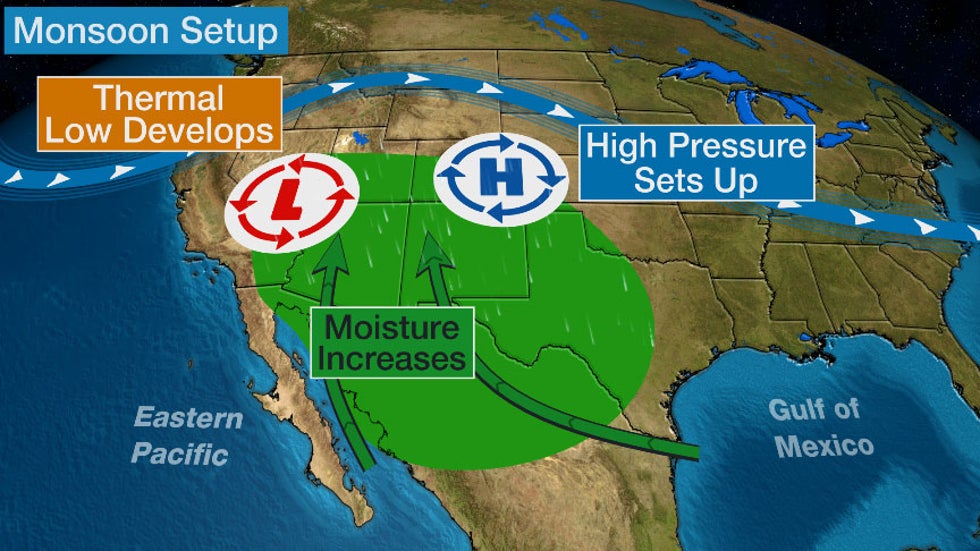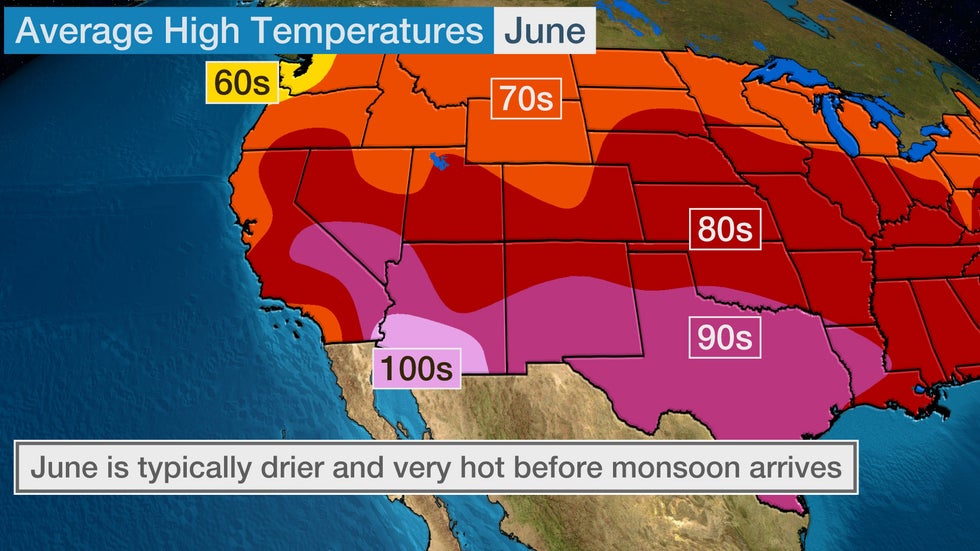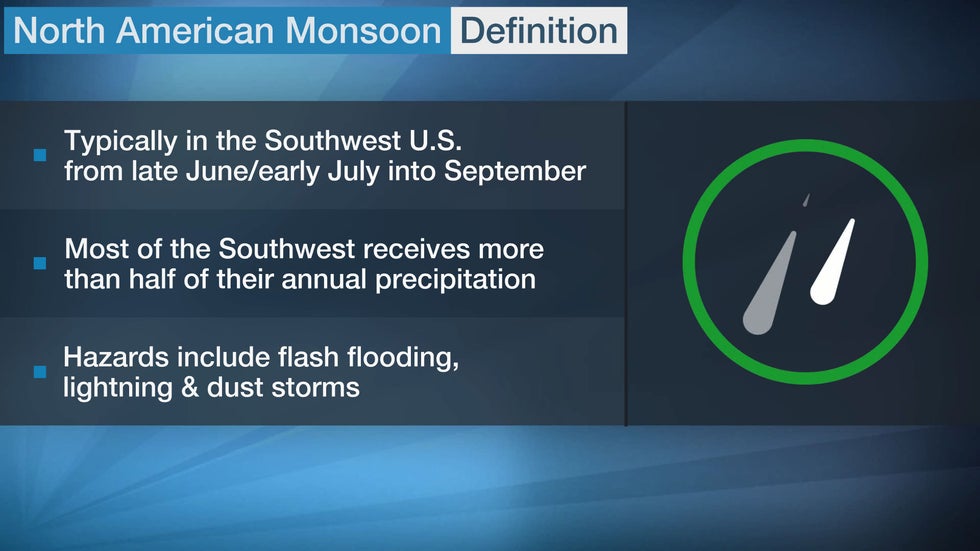Monsoon season in the Southwest is here, but relief from the hot and dry conditions are not expected until later this summer.
Monsoon season starts June 15 in the southwestern U.S., according to NOAA and lasts through Sept. 30. However, in most of the region, it doesn't really kick in until late June or early July.
So what do we mean by monsoon season?
A monsoon is a change in seasonal winds. This occurs in the Southwest each summer when a thermal low develops due to intense heating of the land, but large bodies of water nearby do not warm as quickly. In addition, a ridge of high pressure builds over the Rockies or Plains.
Eventually, pressure differences between the warm land and cooler water cause more humid air from the Gulf of California and the Gulf of Mexico to be drawn toward the Southwest. This flow from moist ocean waters is a change from the usual flow from land areas to the ocean waters.
The result is thunderstorm development.
 Monsoon Setup in the Southwest
Monsoon Setup in the SouthwestRain from these thunderstorms causes humidity to increase which triggers more storms. This cycle continues until early fall when the land finally cools and water temperatures reach their peak warmth, which reduces the pressure difference. As a result, the onshore moisture flow lessens. Occasional breaks in this pattern do occur during the season and the rainfall is not continuous.
Pre-Monsoon Concerns
Hot and dry conditions, with low humidity, prevail in June before monsoon season really gets going.
Fire danger is high due to these conditions. In addition, dry thunderstorms can cause dry lightning and gusty winds. Dry lightning can spark fires and gusty winds can spread them and make them difficult to contain.
Wildfire activity is expected to be above average in much of the Southwest into July before monsoonal rain lowers the risk.
(MORE: Where the Worst Wildfire Activity Is Expected This Summer)
Heat illnesses are another concern before the monsoon starts. Extreme heat can result in heat exhaustion or heat stroke. Signs of heat illness include confusion, dizziness, nausea, fatigue, heat rash and headache. Additional symptoms of heat stroke include a high body temperature, change in sweating, rapid breathing and a racing heart rate.
It is important to get out of the heat, stay hydrated and rest if these symptoms begin. Seek medical help if heat stroke is suspected.
 June Average Temperatures
June Average TemperaturesWhat Does the Monsoon Bring?
In Phoenix, the average onset of monsoon is July 7 or when the dew point is 55 degrees or higher for three consecutive days.
In addition to Arizona, portions of six other states are typically impacted by the Southwest monsoon: New Mexico, Nevada, Utah, Colorado, Texas and California.
The increase in monsoonal moisture ignites scattered showers and thunderstorms across the region during the summer.
This moisture reduces the risk of wildfires and brings much-needed rain to the region for reservoir replenishment and vegetation. Most of northwestern Mexico and the southwestern U.S. receive over half of their annual precipitation from the monsoon.
The monsoon pattern also brings concerns including, heavy rain, flash flooding, lightning, downburst winds and dust storms.
Flash flooding is the leading thunderstorm-related killer and most flash flood deaths occur in vehicles. Never drive through flooded roadways. Lightning also causes injuries and fatalities every year in the United States.
Downbursts are another concern that can result in an outward burst of damaging winds at the ground. Outflow boundaries created by strong thunderstorm downburst winds can cause blowing dust and potentially dust storms, which can significantly and quickly limit visibility.

The amount of relief from the dry and hot conditions the monsoon brings varies from year to year.
For example, last year the monsoon was the ninth driest and third hottest on record for the Southwest, since 1895. This was due to an unfavorable mid-level weather pattern, a decrease in tropical activity in the eastern Pacific and a lack of moisture spreading northward.
The Weather Company’s primary journalistic mission is to report on breaking weather news, the environment and the importance of science to our lives. This story does not necessarily represent the position of our parent company, IBM.
The Weather Company’s primary journalistic mission is to report on breaking weather news, the environment and the importance of science to our lives. This story does not necessarily represent the position of our parent company, IBM.

No comments:
Post a Comment